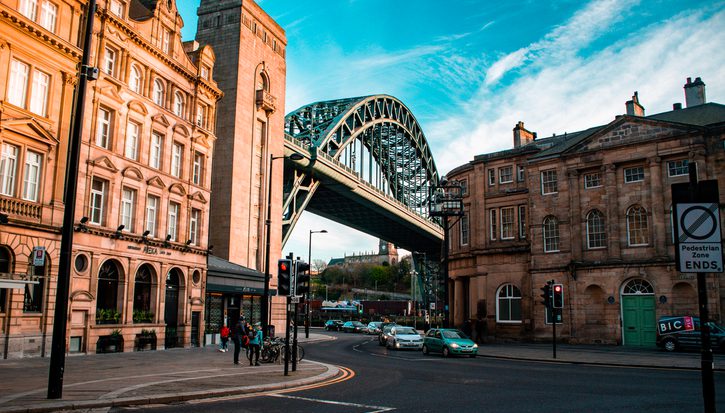
Britons back local leaders with fiscal firepower
Article
“Death and taxes,” they say, are life’s only certainties. But there’s a third - wherever taxes are controlled, power lies.
Here in the UK, that power lies firmly with central government. For every £1 we pay in tax, 96p passes local leaders by and goes straight to the Treasury. And the remaining 4 per cent? Well, they control that too. Our one local lever – council tax – is still shackled by Whitehall, because the government sets parameters on what councils can raise and from who.
To much of the rest of the world, our situation is bizarre. Whether Germany, Japan, or even France (often considered a highly centralised country) more of their tax stays where its raised. Local leaders use them to make local choices. It’s called fiscal devolution, and it works. Leaders who are empowered to tax and spend locally – using their own resources to build the future their communities choose - tend to deliver fairer outcomes, more progressive investment decisions, improved economic growth, better public services and reduced regional inequalities. They also offer a testbed for innovation.
But here in the UK, people aren’t getting out what they’re paying in. Taxes raised in places like the North are being extracted by Treasury and spent on “sugar rush growth” (quick fix investment that doesn’t deliver sustainable, regionally inclusive growth) in London and the South East. People everywhere, are paying the price of this, frankly, broken system.
Nobody wants this. People want control. As one director of culture told us: “People want to do what they want. In their own place. With their own money.”
For every £1 we pay in tax, 96p [...] goes straight to the Treasury
What people want
New polling by More in Common with IPPR shows that the public are broadly supportive of a range of levers to raise and spend money locally.
When asked the extent to which they would support or oppose local leaders having the power to raise funding locally to spend on local improvements, more Britons (35 per cent) supported the idea than those who opposed it (28 per cent). Given this implies people are more supportive of new taxes than not, this finding may come as a surprise to some.
Notably, support increases when the question gets specific. When the public were asked about local transport improvements, support grew to 42 per cent support (with opposition falling to 19 per cent).
The lesson here for policymakers and communicators alike is: when we’re direct about what local levies will be spent on, when people are clear about it improving something specific that they care about locally – like transport – then support increases.
This chimes with other polling which suggests that people are prepared to back bold fiscal decisions if they’re clear that it will result in more money for the things they care about.
Local leaders are, by virtue of being closer to their electorates, more responsive actors. They are ideally placed to show the public how they plan to spend money on local priorities. But, as local spending power has been eroded by years of cuts to local government funding, building the capacity of the local state in a way that will endure – including through fiscal devolution – would be a sensible move.
Visitor levies and the difference they could make
Let’s zoom in on the simple first step of fiscal devolution: visitor levies. They are a small charge applied to visitors’ accommodation and are commonplace in other countries. Here in England they could be an optional tool for local leaders’ armouries through which tourists make a small contribution to a place they spend time in, boosting the experience of that place for tourists and residents alike who get to enjoy the benefits to arts, culture, public services and infrastructure it brings. It wouldn’t take any tax raising or spending power away from Treasury, but it’s an opportunity for local places to take control of spending, and we find that this is something Britons are generally supportive of.
In Barcelona, revenues from taxes on tourism provide the third largest source of municipal income – bringing over €100 million into the city each year to be spent on improving infrastructure, public services and more. However, while Scotland and Wales have recently introduced powers for their local government to introduce similar levies, English mayors do not enjoy such powers. Edinburgh is moving forward with plans to introduce a visitor levy next year, including democratically prudent plans for a percentage of its revenue to go to participatory budgeting. Yet, places in England are resorting to performing fiscal gymnastics – using Business Improvement Districts (BIDs) governed by holiday accommodation providers – to find a workaround and introduce a visitor levy themselves.
People are ready for local visitor levies. They just need to know that it will be used for building up the things that matter to them
However, the public support these powers for local government. 41 per cent of Britons are supportive of visitor levies compared to 32 per cent who are opposed. Indeed, urban areas (52 per cent) and rural areas (50 per cent) had the highest levels of support.
People are ready for local visitor levies. They just need to know that it will be used for building up the things that matter to them – the buses they ride, the trains they take, the celebrations they attend and the streets they call home.
So how could mayoral visitor levies make a difference to the things people care about, in practice? We asked mayoral strategic authorities in England if they have modelled a visitor levy for their area – not everyone has, but here’s what we found:
- Liverpool City Region told us that a visitor levy would raise £10 million annually. They would invest this back into arts, culture, tourism and the visitor economy, making the Liverpool City Region an even more vibrant place to live and visit.
- In Greater Manchester, a £1 to £5 per night tourism levy might generate between £8 million and £40 million per annum. This would contribute to an overall funding package to deliver the infrastructure pipeline through the agreed growth location sites, including the regeneration of Old Trafford and the development of the airport.
- Meanwhile, our friends at Open Innovations, supported by the Northern Powerhouse Partnership have modelled what a visitor levy could raise in local areas across England. You can explore the data on their website, but as an indication they estimate that a £1 visitor levy would raise £7m in the East Midlands Combined Authority.
Maturing devolution
For devolution to mature, fiscal devolution must be on the table – with visitor levies the low hanging fruit to test and learn from. Government could afford this power to mayors through:
- the upcoming English Devolution Bill.
- standalone legislation (like Scotland’s Visitor Levy Act).
- the ‘right to request’ powers afforded to mayors in England through the English Devolution White Paper.
Of course, visitor levies are useful, but they are just one step on the road towards real, fiscal, devolution and they certainly won’t be a silver bullet. Some places will raise more than others. So, we need an honest debate about these trade-offs, as well as necessary mechanisms of redistribution to make deeper devolution fair. Because the UK has deep regional inequalities. Fixing this will require some places with more to act in solidarity to lift up those places with less. Germany’s post-reunification ‘solidarity surcharge’ was a small addition to taxes such as capital gains and corporation tax, and raised billions to ultimately narrow its deep regional divide. This is one model for a progressive mechanism that could move the dial on regional rebalancing in a way that successive governments have failed.
Beyond visitor levies, deeper fiscal devolution needs to be done in a fair and transparent way, with distributionary mechanisms and local flexibilities.
Methodological note
Polling was undertaken on behalf of IPPR and IPPR North by More in Common between 01/04/25-04/04/25. Sample size: 2,071 adults in Great Britain. Respondents have been weighted according to age/sex interlocked, region, and ethnicity, education and GE2024 vote.
Related items

The evolution of devolution: How the English devolution and community empowerment bill can go further
The government’s early commitment to broadening and deepening devolution in England is very welcome, but the bill must be bold enough to make change that people can see and feel.
State of the North 2025 - The kids aren't alright: How to deliver for young people in the North
This year’s State of the North report highlights how regional inequality exacerbates the growing challenges facing many young northerners.
One year in: the government is making decent down payments for the years ahead
It’s fair to say it hasn’t been a straightforward first year for the government.